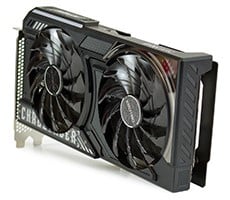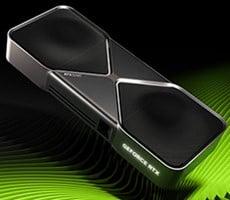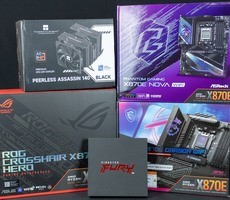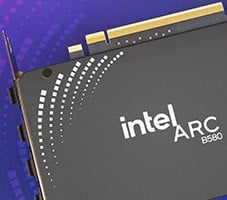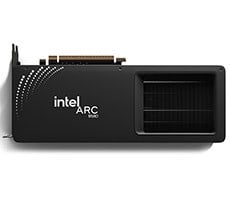The games on this page aren't necessarily the latest or greatest, but what they have in common is that they tend to be extremely demanding. That makes them prime pickings for
GPU performance benchmarking.
Fortnite Battle Royale Benchmarks
Fortnite is surely a game that needs no introduction at this point. We tested it by playing a round in the Zero Build Battle Royale mode, getting a few kills, and then playing back the replay of that section while monitoring the frametimes.
This is, once again, entirely new data, as
Fortnite likes to invalidate players' replays every few weeks when the game updates. The Arc B570 doesn't really impress in this demanding Unreal Engine 5 benchmark, which doesn't bode particularly well for its prospects in future Unreal Engine 5 games.
Elden Ring Open World Benchmarks
You may think Elden Ring is too old to bother testing, but in fact, it's actually extremely demanding thanks to the ray-tracing features added in a patch before the Shadow of the Erdtree expansion came out. That add-on is so voluminous that the Game Awards late last year decided that Shadow of the Erdtree can be a contender for Game of the Year.
Elden Ring is hard capped at 60 FPS without mods, so we had to make sure to use settings that would keep our cards under 60 FPS. This is fairly easily achieved, as it's a pretty demanding game, and these aren't the fastest graphics cards in the world. They handle the challenging workload well, though, and even the slowest card here tops 30 FPS average. The B570 hands in an acceptable performance, although Battlemage seems to have some slightly poor frame-time consistency in this title that we'd like to see Intel nail down.
Guardians Of The Galaxy Benchmarks
Some folks sneered at the Guardians of the Galaxy game because it didn't license the likeness of the film actors, instead preferring to stick to the comic book's designs. That's a shame, because this is actually a really well-put-together package of enjoyable Guardians humor and action combat setpieces.
You know something is wrong when the lowly Arc A580 is dunking on the vastly more efficient Arc B580. Battlemage has problems in this game, and the Arc B570 fares even worse than its bigger brother.
Microsoft Flight Simulator 2024 Benchmarks
A new title for our test suite, Flight Simulator 2024 is the latest release in the long-running franchise. Despite being installed to a very fast Optane SSD, this title is kind of a stutterfest on every single GPU we tested for reasons that are likely unrelated to the GPUs themselves, so we're only reporting average framerates here.
Arc does well overall in Flight Simulator 2024, and Battlemage in particular seems to punch a bit above its weight class here. A great result for the new GPU.
Hogwarts Legacy Wizarding Benchmarks
Whatever you think of the Harry Potter franchise, Hogwarts Legacy is absolutely worth a play if you like open-world action games. The creators poured an incredible amount of love into the title and it really goes a long way toward recapturing the Harry Potter magic for fans, but even if you're not a fan of the franchise, there's a ton to enjoy here. From engaging magical combat, terrifying nighttime exploration, broom-bound aerial acrobatics, fearsome monster taming and more, Hogwarts Legacy is not one to miss..
This is a brutally punishing test, one of the most demanding in our benchmark suite. The Arc B570 holds up reasonably well, although it doesn't have particularly great frame-time consistency here. These settings are asking a lot of a $210 GPU, so we really can't complain that much. It does better than the GeForce RTX 4060 Ti card in that regard, at least, likely thanks to the extra 2GB of onboard memory.
Street Fighter 6 World Tour Benchmarks
For the first time, Street Fighter 6 adds a single-player story mode to the popular one-on-one fighting game. Players create a custom character and travel around the world learning moves from the World Warriors. Not only does it have large open maps with a lot of characters, it also supports a 120-FPS maximum frame rate, unlike the main fighting mode. We tested in the ludicrously-detailed Nayshall region.
Street Fighter 6 gives us one of the more 'as expected' benchmark results in our suite. There's not much to say here, although we'd probably turn the resolution down another notch for this game on the B570, as you really want a 60 FPS minimum, especially for online play.
Starfield Benchmarks
Bethesda's latest game release was undeniably a hit on launch, but the hype has faded a bit since then. It's still a punishing title for PCs, and it's also known to be unfriendly to Intel GPUs, so let's see if that's still the case.
We're not game optimization specialists, so we can't fully explain in detail why
Starfield doesn't run well on Arc GPUs. If you're a dedicated Bethesda fanboy, you should probably look elsewhere for your GPU hardware.
Teardown Voxel Destruction Benchmarks
Teardown is an indie game primarily created by a single individual that relies on voxels for all of its in-game objects. This gives it a number of very interesting advantages, technologically, such as the ability to do full path-traced global illumination very cheaply due to the low-rez voxel environments and objects. Rather than using hardware RT acceleration, though, it's all done in regular GPU compute.
In contrast to
Starfield,
Teardown absolutely loves Intel Arc, and runs like a dream on the B580 and A770. It runs very well on B570 too—especially considering the price.
F1 2024 XeSS FG Benchmarks
If the numbers on this next chart look really extreme, that's because we tested it using frame generation. This technology essentially doubles the frame rate of your game as long as you have the CPU and GPU headroom available to do the frame generation processing. Since we're effectively applying a multiplier to the frame rate, it makes the differences in these GPUs look bigger than they are.

Just as with the Arc B580 review, w
e used DLSS frame generation on the NVIDIA cards, AMD FSR3 frame generation on the Alchemist and Radeon cards, and then the new XeSS FG on the Arc B570 and B580. As you can see, the Arc B570 handles this game with aplomb, even with the settings set to "Ultra High", which makes this sim racer quite the visual feast.
We still haven't done dedicated testing of XeSS FG, but speaking subjectively, it seems to be functionally similar or even equivalent to NVIDIA's DLSS Frame Generation. DLSS FG can generate visual artifacts, yet due to the high frame rates, it's usually very hard to notice them. Likewise, we couldn't spot anything out of place with XeSS FG across a half-dozen races and benchmarks, although it's worth noting that F1 2024 is basically a best-case scenario for frame-generation technology with its clean presentation and uncluttered environment design. We're eager to see XeSS FG in more chaotic games to see how it holds up.
Dragon's Dogma 2 Benchmarks
On its release early last year, Dragon's Dogma 2 caught a lot of attention for its shockingly CPU-limited nature in large towns full of NPCs. This sort of distracted everyone from the fact that it's also extremely GPU-heavy, at all times. The game is well known to hate Alchemist; let's see how Battlemage does.
Well, the B570's ahead of the Alchemist cards, at least. Actually, 30 FPS is serviceable in this game and even the Arc A770 turns in an acceptable performance. The Arc B570 is just ahead of that card, and it sips power in comparison, so this result isn't too shabby...until you look at the four-year-old GeForce RTX 3060 above it. Definitely some optimizations to be done for RE Engine in the Arc driver.
Cyberpunk 2077 Ray-Tracing Benchmarks
Our last game benchmark is going to be Cyberpunk 2077, of course. If you were waiting for it, well, here it is. We were surprised at these results, so we ran them numerous times to make sure they were accurate... and they were.

We established Battlemage's prowess in this game in our B580 review, but it's pleasing to see the Arc B570 riding just behind its bigger brother and the GeForce RTX 4060 Ti. It manages to outpace the much larger Radeon RX 7700 XT here, which is very good. How about in the path-traced "RT Overdrive" mode?
This isn't a particularly playable result for the Arc B570, but this is about as demanding as our benchmarks get. It's notable that the B570 completes the benchmark with no particular artifacts or errors, and that it does so with a pretty consistent frame-time, too. It just really doesn't have the grunt for this workload.
Looking back over the performance results, the ASRock Challenger Arc B570 really is pretty much an Arc B580 with around a 20% performance reduction. What about that thing where Battlemage is apparently really sensitive to CPU speed, though? Head to the next page and find out.













